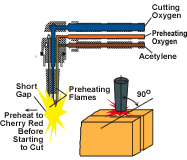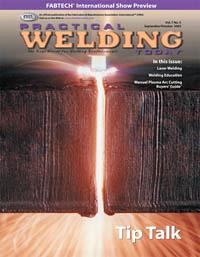Contributing Writer
- FMA
- The Fabricator
- FABTECH
- Canadian Metalworking
Categories
- Additive Manufacturing
- Aluminum Welding
- Arc Welding
- Assembly and Joining
- Automation and Robotics
- Bending and Forming
- Consumables
- Cutting and Weld Prep
- Electric Vehicles
- En Español
- Finishing
- Hydroforming
- Laser Cutting
- Laser Welding
- Machining
- Manufacturing Software
- Materials Handling
- Metals/Materials
- Oxyfuel Cutting
- Plasma Cutting
- Power Tools
- Punching and Other Holemaking
- Roll Forming
- Safety
- Sawing
- Shearing
- Shop Management
- Testing and Measuring
- Tube and Pipe Fabrication
- Tube and Pipe Production
- Waterjet Cutting
Industry Directory
Webcasts
Podcasts
FAB 40
Advertise
Subscribe
Account Login
Search
Identifying the right welding and cutting torch tips
Understanding torch tip design and function
- By John Uccellini
- Updated October 25, 2023
- October 9, 2003
- Article
- Consumables
The tip of a welding or cutting torch is where the action is (see Figure 1). Welding tips usually produce positive pressure (higher than 1 pound per square inch [PSI]) and are used at equal pressures of acetylene and oxygen. These single-hole copper-alloy tips are attached to a torch handle equipped with a mixer that mixes the fuel with the oxygen, much like a carburetor in a car mixes the gas and air.
 |
| Figure 1 Welding tips mix oxygen and fuel, and then the mixed gas is pushed through the welding tip and is burned at the tip end. |
Unfortunately, the best size and uniformity of welding and cutting tips to use can be a source of confusion for users.
Cutting Torch Tip Design
Tip design is based on the flame characteristics of the fuel gas used, as well as the intended use of the cutting tip. Cutting tips come in one-piece and two-piece styles.
One-piece tips are used with acetylene and are made from copper alloy to withstand the heat of the cutting process (see Figure 2). The copper alloy is machined, drilled, and swaged over special wires to produce exact holes for preheats and cutting oxygen bores. Tolerances must be controlled carefully to produce stable cutting tips.
 |
| Figure 2 One-piece tips have (1) a cutting jet oxygen passage and (2) preheating flame passages. |
Acetylene tips are manufactured with four or six preheat holes and are produced to allow light, medium, and heavy preheats for use with clean, dirty, or rusted plate. Rivet-washing tips use a low-velocity cutting oxygen stream to blow rivets through a plate without damaging it. Tips also are available for gouging out welds, cutting sheet metal, and other specialized uses.
One-piece tips can be used with methylacetylene-propadiene (MAPP®) and propylene. They have eight preheat holes to provide the extra heat required for these gases. However, two-piece tips generally provide the best results with MAPP gas and propylene.
One-piece tips have oxygen bores that come in two configurations: a straight bore using 40 to 60 PSI for hand cutting and a divergent bore that has a tapered or flared outlet hole for use in machine cutting. The divergent-bore tips use higher outlet pressures of 70 to 100 PSI and allow for a 25 percent increase in cutting speed over straight-bore tips.
 |
| Figure 3 Two-piece tips consist of (1) an outer shell, (2) an inner member, (3) grooves for preheating flames, (4) extremities of grooves, and (5) a cutting oxygen passage. |
Two-piece tips consist of an outer shell and a splined insert (see Figures 3 and 4). The splined insert is used to eliminate the need to drill the numerous preheat holes required for the cooler- and slower-burning fuel gases. Different spline configurations allow different fuel gases to burn more efficiently.
Propylene and MAPP provide the most efficient preheats using fine, rectangular splines and a very slight recess of the insert into the front face of the shell to anchor the preheat flames. For natural gas, methane, and propane, V-splines make preheats more efficient. Small tips usually have small splines, and large tips use wide V-splines. These gases require a deeper recess between the insert and the shell to better anchor the preheat flames of these slower-burning gases.
 |
| Figure 4 Two-piece tips are used for alternative fuel gases such as natural gas, methane, propylene, MAPP, and propane. This figure shows a cutting torch starting a cut and in action. |
Like in one-piece tips, the oxygen bores in two-piece tips can have a straight or divergent configuration, and specialty tips are available for washing and gouging.
Matching Cutting Torch Tips to Processes
Gas welding can be accomplished only with oxyacetylene or MAPP. These gases have a reaction that absorbs heat (endothermic). The other common fuel gases—methane, natural gas, propylene, and propane—have a reaction that releases heat (exothermic).
Therefore, acetylene and MAPP are endothermic and burn with the release of heat, a positive BTU factor, while the other fuel gases are exothermic and burn with the absorption of heat, a negative BTU factor. The result is that acetylene and MAPP deliver high heat output to the primary cone that is used to gas-weld.
Acetylene is the most efficient gas for gas welding. Methylacetylene-propadiene usually requires a tip that is one or two sizes larger to weld the same material thickness.
Acetylene is an explosive gas. For this gas to be stabilized in cylinders, the cylinders must have a porous mass packing material with small cellular spaces in which acetylene gas can collect. The porous mass is saturated with acetone, in which the gaseous acetylene dissolves. Maximum acetylene cylinder pressure is limited to 250 pounds per square inch gauge (PSIG) at 70 degrees F.
Acetylene withdrawal pressure is 15 PSIG. To minimize the withdrawal of acetone, acetylene should not be withdrawn at a rate of more than 1/10 the capacity of that cylinder per hour of intermittent use or 1/15 for continuous use.
Brazing and soldering can be accomplished with welding tips that use any common fuel gas because they do not require the higher heat that fusion requires. Welding tips to be used with alternative fuels often require a recess at the tip outlet to prevent the flame from blowing off the tip end.
A heating tip is attached to a torch handle with mixers that mix the fuel and oxygen and supply it to the tip. One common mistake welders make when using heating tips is to starve the tip by not supplying it with enough fuel. Lack of fuel causes the flame to regress into the tip, resulting in backfires and flashbacks. Welders need to be aware of the fuel supply requirement for the heating tip they are using and maintain that supply of gas by manifolding cylinders together if necessary.
There is a limit to how much gas can be withdrawn from a single cylinder. Many welders try to run large heating tips off a single cylinder of acetylene. The maximum withdrawal rate for a large, 300-cubic-foot acetylene cylinder is only 30 cubic feet per hour. This is enough acetylene to run only a very small heating tip.
If a heating tip starts to backfire, the welder needs to shut the tip down and check the fuel gas supply. Continuing to work with a backfiring tip can be hazardous to the equipment and dangerous to personnel.
Check valves and flashback arrestors can help prevent reverse flow, backfires, and flashbacks. These devices are designed to enhance operating procedures and help protect personnel and equipment when dangerous conditions exist.
Welders must be sure to check the capacity of the check valves and flashback arrestors used to ensure they have the flow capacity needed. A check valve or flashback arrestor without sufficient flow capacity can restrict flow and create serious problems.
Of course, no device can replace safe operating practices and properly maintained equipment.
 |
| Figure 5 Bore size and tip orifice size are important considerations when choosing a welding or cutting tip for an application. |
Sizing Cutting Tips for Torches
Sizing and standardizing cutting, welding, and heating tips can be a real challenge because manufacturers assign numbers to their tips that have no relationship to bore size, material thickness, or anything else (see Figure 5). For example, Manufacturer A may call a tip that cuts 1/2-inch steel a Number 1, while Manufacturer B calls it a Number 2, even though both have the same oxygen drill size of about 0.038 inch.
The American Welding Society (AWS) has been urging tip manufacturers to stamp tips with the material thickness size to eliminate the confusion of tip size numbers. In 2000 AWS issued the ANSI-AWS C4.5M Uniform Designation System for Oxy-Fuel Nozzles. This standard calls for tips to be stamped with the name of the manufacturer, a symbol to identify the fuel gas, the maximum material thickness, and a code or part number to reference the manufacturer's operating data.
However, because the standard is not mandatory, many manufacturers are not in compliance because of the additional cost of changing or adding stamps. A second factor affecting compliance is that the standard requires the use of metric measurements for thickness and flow.
Matching different manufacturers' cutting tips involves checking the oxygen bore sizes. They all are about the same because the amount of oxygen put into the cut remains the same. Too much or too little oxygen has an adverse effect on the cut.
Welding tips from different manufacturers can be matched by orifice size; heating tips are matched by BTU output using the intended fuel gas. The welder must check the amount of fuel gas required to run the tip and be sure to provide sufficient gas to run the tip without backfires and overheating.
John Uccellini is manager of technical services for CONCOA, 1501 Harpers Road, Virginia Beach, VA 23454, 800-225-0473, fax 757-422-3125, e-mail@concoa.com, www.concoa.com.
MAPP is a registered trademark of BOC Gases.
About the Author
About the Publication
subscribe now

The Welder, formerly known as Practical Welding Today, is a showcase of the real people who make the products we use and work with every day. This magazine has served the welding community in North America well for more than 20 years.
start your free subscription- Stay connected from anywhere

Easily access valuable industry resources now with full access to the digital edition of The Fabricator.

Easily access valuable industry resources now with full access to the digital edition of The Welder.

Easily access valuable industry resources now with full access to the digital edition of The Tube and Pipe Journal.
- Podcasting
- Podcast:
- The Fabricator Podcast
- Published:
- 04/16/2024
- Running Time:
- 63:29
In this episode of The Fabricator Podcast, Caleb Chamberlain, co-founder and CEO of OSH Cut, discusses his company’s...
- Industry Events
16th Annual Safety Conference
- April 30 - May 1, 2024
- Elgin,
Pipe and Tube Conference
- May 21 - 22, 2024
- Omaha, NE
World-Class Roll Forming Workshop
- June 5 - 6, 2024
- Louisville, KY
Advanced Laser Application Workshop
- June 25 - 27, 2024
- Novi, MI































